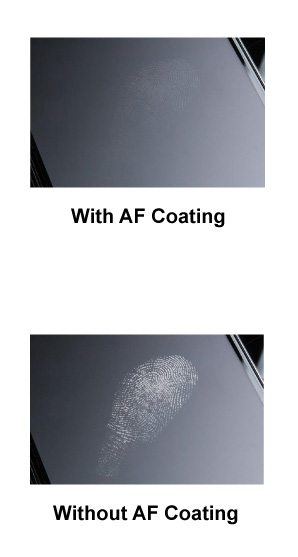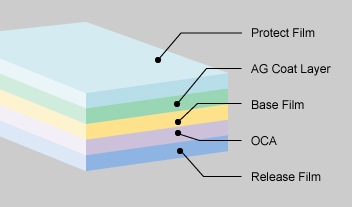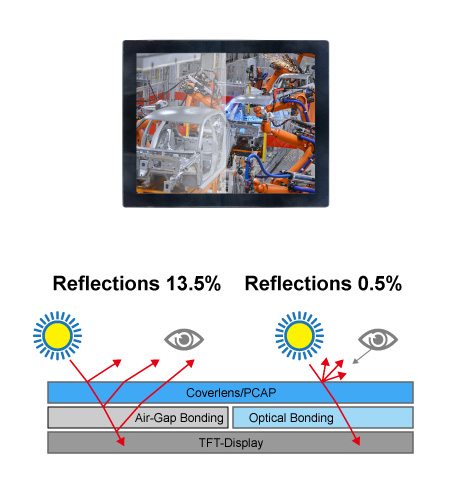Panel PC Solutions with
Advanced Display Technologies
Optimized Visibility | Touch Condition Variation |
Fulfilling the unique OEM/ODM requirement
We provide value-added custom panel technology solutions for computing applications that require special treatment(s) on its display panel in order to deliver the best display quality and user experiences. Such solutions include Sunlight Readable, Surface Coating (Anti-Reflection, Anti-Glare, Anti-Finger Print), Surface Protection and Bonding Technology. The treatment options vary depends on the environment and requirements the device is going to operate in. Please consult with our sales engineers for more information.
Sunlight Readable
On an average sunny day, the illumination of ambient daylight is approximately 30,000 nits. In order to deliver a clear image on an outdoor display device, the brightness of the panel must reach at least 900 nits. While the panel's brightness performance is a challenge for outdoor applications, the capability to withstand the extreme temperature is another criteria that needs consideration.
A good panel computing device is not only able to serve in extreme temperature conditions, but also can be readable when exposed to direct or indirect sunlight, glare, and reflection. Most of the panel displays are not properly equipped to handle such critical conditions. We provide several types of brightness enhancement solutions to meet customers’ requirements, especially for outdoor applications.
To respond the challenge of brighter display, LED backlighting has been developed to achieve and maintain the required brightness levels. We provide active brightness enhancement up to 1500nits; the high brightness is to ensures excellent visual readability under any lighting condition.
Benefits:
- Improve display contrast and readability
- Improve display clarity and image quality
- Superior uniformity
- Improved operating temperature range and brightness
- Low power consumption
- Enhance color saturation and view angle
- Full mechanical and electronical compliance with current system

Surface Coating
Surface coating can be used at indoor and outdoor environments by enhancing optical performance of the displays. We provide 3 different types of surface coating technologies for PCAP touch: Anti-Glare, Anti-Reflection, and Anti-Finger print.
Anti-Glare (AG) Treatment
There are 2 different types of treatments for glass with Anti-Glare processing: chemical-based and acid etching.
A chemical-based surface treatment (chemical AG process) is applied directly to the glass surface to form micro asperities, giving the glass an anti-glare effect under sunlight. This treatment maintains high surface strength of the glass because it does not generate any minute flaws (micro-cracks), which is the common character of mechanical AG processes.
The other AG treatment is manufactured by controlled acid etching process, yielding uniform diffused surfaces for anti-glare. Varying levels of diffusion can be specified, as gloss yield different levels of reduced glare. A lower gloss reading denotes a more diffuse panel. The haze ratio of AG glass used on OGS touch screen products cannot be too high, because high levels of haze would affect LCM transmittance. See below figure to have more understanding on specification categories for anti-glare glass.


Striped Rows
| AG Glass | Cell Phone (OGS) | Monitor/NB (OGS) | Cover Lens |
|---|---|---|---|
| Haze (%) | 1.0 ~ 3.0 ± 0.5 | 3.0 ~ 5.0 ± 0.5 | 70 ~ 30 ± 5 |
| Gloss Unit (GU) | 85 ~ 95 | 80 ~ 90 | 10 ~ 50 |
| Ra (Roughness) | < 0.2 | < 0.4 | 0.4 ~ 1.5 |
| Transmittance (%) | 90 ~ 95 | 85 ~ 90 | 80 ~ 90 |
Anti-Reflection
An Anti-Reflection (AR) coating is a type of optical coating applied to the surface and other optical elements to reduce reflection by vacuum evaporation process. In typical imaging systems, this improves the efficiency, since less light is lost due to reflection. In complex system such as telescopes and microscopes, the reduction in reflections also improves the contrast of the image by elimination of stray light.
AR produces destructive interference in the beams reflected from the interfaces and constructive interference in the corresponding transmitted beams, which increases the transmittance of glass or transparent substrates. The transmittance of glass is approximately 91%, and with single-sided coating, the transmittance can be increased to 94~95% double-sided coating can increase transmittance up to 98~99%.


Anti-Fingerprint (AFP)/ Anti-Smudge (AS)
Anti-Fingerprint (AFP) provides many great features for panel computers. It is a coating that prevents imprints and smudge left on the glass surface. In addition, the AF coating provides hydrophobic (water resisting) and scratch resistance performance, protecting Anti-Reflection layers, and reducing friction.
The hydrophobic performance is evaluated in each lot by measuring the contact angle. The AF effect is realized by applying a nano-coating to reduce the optical contrast of fingerprints.
The AFP effect means that fingerprint on the surface cannot be seen at all by the naked eye, or only very slightly. Although the fingerprint is actually on the surface, it is essentially “invisible”. The color to be coated under visible and infrared light is transparent. Coating improves characteristics like low coefficient of friction, with contact angle >100 degree. It utilizes a vacuum coating process, which is also thinner and more evenly distributed than spread coating. The degree of environment pollution with this method is the lowest.
Benefits:
- Very low surface reflections
- High transmission for visible wavelengths
- No ghost images, phantom light, or double laser beams
- Low light absorption
- High abrasion resistance and coating adhesion
Surface Protective Film
Glass is often considered the weakest point of PCAP touch products. There are numbers of situations that could result in a broken glass, including extreme weather, vandalism, and occasionally “out of bounds” usage. Adding protective films on the glass surface helps improve the safety of use and longevity of the display. When attempting to shatter the glass panel, the security film will hold the glass in place, reducing the overall impact of the breakage. Surface Protective Film include:
The working principal for Anti-Glare, Anti-Reflection film are same as coating process. They both gain optical benefits.
AG films reduce the sparkling of high-definition displays such as LCDs.
AG films with AR function reduce the glare of display with hue kept in neutral.
Clear AR films enhance scratch resistance, which is important with everyday use.
Smooth contact AG films allow fingers to glide across the surface.
Anti-Vandal film works by protecting the glass substrate from damage and can be easily removed and replaced by a new film. This provides a quick and cost-effective solution for products used in public and private spaces, protecting from damage and visual distortion caused by graffiti and reckless vandalism.
Anti-UV film is applied for Panel PCs working at outdoor or semi outdoor locations. Even with indirect sunlight, ultraviolet light can damage the structure of the touch and cause OCA film yellowing and aging issues. With Anti-UV film, we can prevent undermining the surface and extend the use of life for outdoor products. It also rejects up to 97% of infrared light coming from sunlight and insulate up to 60% of the solar energy, keeping the touch surface and system away from heat issues.
| PR20 | PR40 | PR50 | PR60 | PR70 | |
|---|---|---|---|---|---|
| Visible Light Transmitted | 21% | 39% | 50% | 60% | 69% |
| Visible Reflection Exterior | 6% | 7% | 8% | 8% | 9% |
| Visible Reflection Interior | 5% | 7% | 7% | 8% | 9% |
| UV Rejection | 99.9% | 99.9% | 99.9% | 99.9% | 99.9% |
| Total Solar Energy Rejected | 62% | 60% | 56% | 53% | 50% |

Benefits:
- Perfect adhesive performance with perfect adhesion, holding power and long-lasting protection
- Suitable hardness provides scratch resistance
- Prevent graffiti and vandalism from interrupting the touch function
- Anti-UV and infrared light protection for outdoor applications
Bonding Technology
There are two major bonding technologies used in normal practice for industrial panel PCs - air gap bonding and optical bonding.
Air gap bonding uses a framed adhesive with a gasket that leaves behind a small air bubble in the part stack up. This is a popular bonding method for devices because of its lower cost when compared to other bonding options. However, it also presents challenges in product design - an air gap is formed when the layers are integrated with a gasket. It can be difficult to read the screen in bright light and causes the product to be more susceptible to moisture damage and breakage.
To solve above situation, optical bonding technology plays an important role in the display when the product is installed in humidity, outdoor, or harsh environments. Using proprietary materials and unique re-workable process, we provide the most advanced and cost-effective optical bonding solution that enable sunlight readability and provide extra vandal resistance for outdoor displays.
For industrial PCs used in outdoor or in a critical environment like fog, mirror image on the display, and lower panel brightness, optical bonding can easily solve these issues. Optical bonding technology decrease reflection level and delivers clear viewing angles. It significantly improves display readability with standard brightness in sunlight.
- Reduction of reflections at the interfaces inside stack-up
- Improvement of extrinsic contrast value
- Protects the display from moisture and dust
- UV Protection & resistance (anti-UV, UV cut 3,000 hrs+)
- Extended temperature range (-50~105°C)
- Elimination of parallax from a flat viewing angle
- No water condensation & contamination
- Higher stability in bumps and falls and better impact protection

Easy Touch Mode change for PCAP
The majority of touch screens used today is dominated by two types of touch screen technologies - Projected Capacitive (PCAP) and Resistive Touch. For embedded computing applications, PCAP touch is the preferred selection because it turns the surface in the front of the display into a modern user interface.
Resistive touch screen was launched about 20 years ago. It is still a popular choice for factory automation applications because of lower cost, and how the variety of pressure-sensitive surfaces react to touch objects such as finger, gloves, pencils or tools. Resistive touch suffers from reduced light transmittance in comparison with PCAP, and therefore decreases the sought-after brightness of the underlying TFT-LCD.
Resistive touch needs to be calibrated from time to time. The driver needs to be updated, and surface of resistive touch also has lifetime issues. Direct contact between the finger and the PCAP touch sensitive surface is not needed for operation. A glass plate may be mounted as an outer transparent protective layer without interfering with the touch functionality. The choice of material and thickness of the plate may even protect the system from vandalism in public places. It’s worth mentioning that the operating life of the touch screen is generally well over the operating life of the display.
We have been developing a touch mode change user interface (UI) under Windows operating system allowing users easily change the touch mode with just one click. Rebooting is not required for making the mode change. We provide up to three different kinds of touch mode for users to select, such as water, snow, glove and etc. This customized service has increased the working efficiency for customers who need to install their Panel PC at different places.

Contact us at BCMSales@bcmcom.com or give us a call 949-470-1888
Understand more about our Custom Industrial Motherboards and Open Frame Tablets
